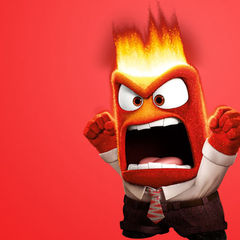Therefore, Jimmy
Porter is often considered to be the perfect example of the Angry Young
Men. Jimmy is angry at all the social
and political structures that he believes has impeded him to achieve his dreams
and aspirations. Throughout the entire play, Jimmy expresses his discontent
towards a discriminatory society that only benefits those belonging to the
upper-class. In Jimmy’s view, the upper-class members
symbolize the fake aristocratic society which is incapable of having genuine
feelings for any human being.
Jimmy tries to live the day-to-day in a world
of dead ideas that is destroying him and the ones he loves. His impetuous,
violent language that is full of rage is Jimmy’s beast weapon in his attempt to
awaken people’s feelings and expose this abusive society. The anger
expressed through his language is just a reflection of the discontent and
rejection he felt for society.
At first, when I started reading the play the
first thing that came to mi mind was ‘What a sad man, he does nothing but
complain about everything’. However, the more you get involved with the play,
the more you can feel identified with him and understand part of his anger. And
honestly, I think I do. And I’m not saying that I agree in everything with
Jimmy (because I don’t, especially in his way of acting), but I truly
understand him.
However, Osborne is not the only one who has
tried to venture in this topic related to social nonconformity, discontent and
anger. Allen Ginsberg's Howl is one of the most famous poem to come
out of the Beat Generation. His poetry depicts the overall freedom the Beat
poets strived for, which in certain way is related to what Jimmy aspirates in
life.
Jimmy attributes all
of the injustice to the sociopolitical entities, which are represented in
Ginsberg’s poem as “Moloch”. For Ginsberg, all of the American destruction caused
by greed, war or blind patriotism is represented by Moloch. Through his poem,
Ginsberg captures an entire generation that sacrifices its soul, freedom to a
set of false values.
Nevertheless, this
is not the only aspect that these works have common. For both, Jimmy and Ginsberg, language was
the weapon they used to fight. It just like the only recourse left to let all
the anger out was words. And let me tell you, words are powerful, no doubt
about it! But do I think it’s the only way? No.
For my perspective, Jimmy Porter’s anger could have been used for so
much more than just cursing.
Before starting debating about if it is ok or
not to be mad at everything (or anything), let’s talk about the definition of
this famous word “Anger”. As you may
find in Cambridge Dictionary (or whatever dictionary you are reading), anger is
defined as “a strong feeling that makes you want to hurt someone or be
unpleasant because of something unfair or unkind that has happened”. Wait, did you know that? Right, of course.
That may be because all of us has felt angry before (and I’m pretty sure that
more than just once).
So if you thought that the only angry people
who seemed to reject society where those Chilean students that try to fight
against the “Reforma a la Educación Superior”, let me tell you that you are so
wrong my friend. Well, let’s say that anger and disconformity are like
universal feelings and that they don’t belong only to those who want everything
for free. On the contrary, it seems like somehow people have the physiological
need to criticize, judge and complain about things in general. But, is it
wrong? If you look at it from Jimmy’s point of view, anger is what makes us
feel alive, what makes us human; otherwise we would be just like Allison. For
him, acquiescence is merely a synonym for mediocrity.
However, anger is a double-edged sword. Personally, I believe that there is nothing
more harmless that just one resentful man, and at the same time there is
nothing more powerful than a bunch of angry people. Union is what really makes
force. If you don’t complain about anything, how people are supposed to know
that things aren’t going well?
Here is when it comes my criticism. What called my
attention is that Jimmy doesn’t do anything about his anger. It seems that
violence is the solution, when it is actually not. And that’s the thing! Jimmy
is still surrounded by the things he hates. He keeps stuck in the same place
and the only thing he does is insulting the people whom he has decided to live
with. Violence does not lead him to anywhere and it doesn’t open people’s eyes.
Words alone are not going to change the world, but actions! Jimmy should try to
look for a more productive solution instead of sinking into his anger. So my
advice is: meet with people that feel frustrated at the same things you do and
try to do something about it. Start a Revolution! That’s when anger becomes
positive.
Bibliography
Afolayan, B. (2012) Poetics of Anger in Jonh
Osborne’s Look Back in Anger and Femi Osofisan’s The Chattering and The Song.
British Journal of Arts and Social Sciences, 5(1), 123-141. Retrieved from http://www.bjournal.co.uk/paper/bjass_5_1/bjass_05_01_13.pdf
Clurman, H. (1968). John Osborne: Look Back in Anger: A Collection of Critical Essays.
John Russell Taylor (ed.), London: Macmillan
Ginsberg, A. (2006).
Howl. Spain: Anagrama.
Haque, S. (2013) “The role of Colonel Redfern in
Osborne’s Look Back in Anger: A critical analysis”. Researchers World, 4 (1), 33-39. Retrieved from
http://www.researchersworld.com/vol4/vol4_issue1_1/Paper_04.pdf
Osborne, J.
(1957). Look back in anger, a play
in three acts. New York: Criterion Books.
Worth, Katherine J., (1963). ‘The Angry Young Man’ in Experimental Drama.
London: G.Bells and Sons Ltd


No hay comentarios:
Publicar un comentario